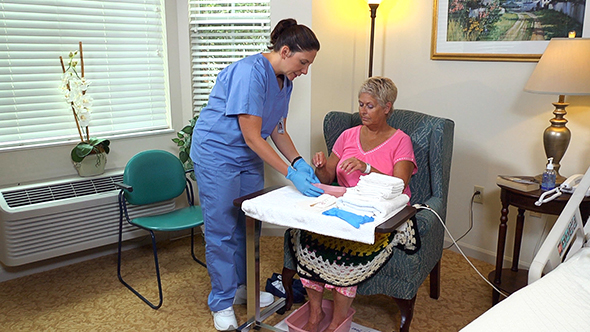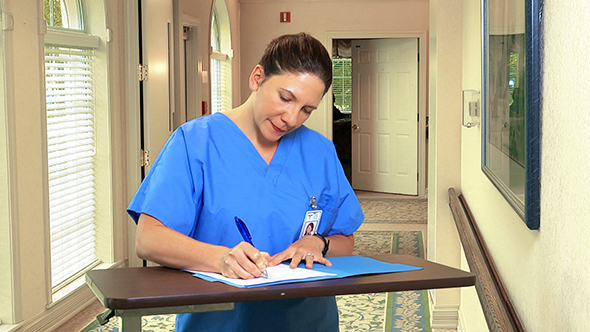Personal Hygiene and Grooming
Select a Skill:
- » Performing Oral Hygiene
- » Providing Denture Care
- » Brushing and Combing the Person's Hair
- » Shampooing the Person's Hair
- » Shaving the Person's Face
- » Giving Nail and Foot Care
- » Assisting with Undressing and Dressing
- » Changing the Gown of the Person with an IV
Take the Review Test:

Purpose

- Nail and foot care prevents infection, injury, and odors. Hangnails, ingrown nails, and nails torn away from the skin cause skin breaks. These breaks are portals of entry for microbes. Long or broken nails can scratch the skin and snag clothing.
- Dirty feet, socks, or stockings harbor microbes and cause odors. Shoes and socks provide a warm, moist environment for microbes to grow. Injuries occur from stubbing the toes, stepping on sharp objects, or being stepped on. Shoes that fit poorly cause blisters.
- Poor circulation prolongs healing. Diabetes and vascular diseases commonly cause poor circulation. Infections or foot injuries are serious for older persons and persons with circulatory disorders. Trimming and clipping toenails can easily cause injuries.
- Nails are easier to trim and clean after soaking or bathing. Use nail clippers to cut fingernails. Never use scissors. Use caution to avoid damage to nearby tissues.
Equipment
Roll cursor over items to see labels. For the purposes of clearly depicting the equipment, a barrier is not shown in this photo. When providing care, a barrier should always be placed on the surface before placing the equipment.

Bath mat
Wash basin
Hand towel
Bath towel
Washcloth
Paper towels
Gloves
Soap
Lotion for the hands
Lotion or petroleum jelly for the feet
Bath thermometer
Nail clippers
Orangewood stick and Emery board or nail file
Kidney basin
Delegation
- Follow delegation guidelines. Before giving nail and foot care, obtain this information from the nurse and care plan:
- What water temperature to use
- How long to soak fingernails—usually 5 to 10 minutes
- How long to soak feet—usually 15 to 20 minutes
- What observations to report and record
- When to report observations
- What patient or resident concerns to report at once
Preparation

- Observe quality-of-life measures.
- Review the information under Delegation and Safety and Comfort.
- Practice hand hygiene.
- Collect the items needed for nail and foot care.
- Arrange paper towels and other items on the over-bed table.
- Identify the person. Check the ID bracelet against the assignment sheet. Also call the person by name.
- Provide for privacy.
- Assist the person to the bedside chair. Remove footwear and socks or stockings. Place the call light within reach.
Safety

- Some states and agencies do not let nursing assistants cut or trim toenails. The nurse or podiatrist cuts toenails and provides foot care for people who:
- Have diabetes or poor circulation to the legs and feet.
- Take drugs that affect blood clotting.
- Have very thick nails or ingrown toenails.
- Check between the toes for cracks and sores. If untreated, an infection could occur.
- The feet are easily burned. Persons with decreased sensation or circulatory problems may not feel hot temperatures.
- After foot cleaning, apply lotion or petroleum jelly. This can cause slippery feet. Help the person put on non-skid footwear before transferring or letting him or her walk.
- Breaks in the skin and bleeding can occur. Follow Standard Precautions and the Bloodborne Pathogen Standard.
Comfort
- Sometimes you just trim the fingernails. Sometimes you just give foot care. When you do both, the person sits at the over-bed table. Provide for warmth and comfort.
- Promote your own comfort during nail and foot care. Sit in front of the over-bed table to trim and clean fingernails. For foot care, rest the person’s lower leg and foot on your lap. Or position the feet on the floor and kneel on the floor. Lay a towel across your lap or a bath mat on the floor to protect your uniform. Use good body mechanics. Always support the person’s foot and ankle when giving foot care.
Procedure Video
Audio Description: OFFFollow-up Care

- Provide for comfort.
- Place the call light within reach.
- Raise or lower bed rails. Follow the care plan.
- Clean, rinse, dry, and return equipment and supplies to their proper place. Discard disposable items. Wear gloves.
- Unscreen the person.
- Complete a safety check of the room.
- Follow agency policy for dirty linens.
- Remove and discard the gloves. Practice hand hygiene.
Reporting/Recording
- Report and record your observations, including:
- Dry, reddened, irritated, or callused areas
- Breaks in the skin
- Corns on top of and between the toes
- Blisters
- Very thick nails or loose nails.
Review Questions
Select the best answer.
1. What is a purpose of giving nail and foot care?
 To prevent injury
To prevent injury To prevent diabetes
To prevent diabetes To manage vascular disease
To manage vascular disease To improve circulation to the hands and feet
To improve circulation to the hands and feet
Select the best answer.
2. When is the best time to perform nail and foot care?
 Right after the person’s bath
Right after the person’s bath Before giving a shower or a tub bath
Before giving a shower or a tub bath After soaking the hands and feet for 30 minutes
After soaking the hands and feet for 30 minutes After assisting with hair care or a shampoo in bed
After assisting with hair care or a shampoo in bed
Select the best answer.
3. When giving nail and foot care, which safety precaution should you observe?
 Use hot water to soak the hands and feet
Use hot water to soak the hands and feet Avoid lotion on the person’s feet to avoid slipping
Avoid lotion on the person’s feet to avoid slipping Follow Standard Precautions during nail and foot care
Follow Standard Precautions during nail and foot care Trim toenails in a round shape, cutting off and filing the corners
Trim toenails in a round shape, cutting off and filing the corners
Select the best answer.
4. Which person should have his or her toenails cut by a podiatrist?
 A woman, age 59, who has diabetes
A woman, age 59, who has diabetes A man, age 76, who has renal disease
A man, age 76, who has renal disease A woman, age 38, who has pneumonia
A woman, age 38, who has pneumonia A man, age 61, who has a fractured hip
A man, age 61, who has a fractured hip
Select the best answer.
5. After giving nail and foot care, you apply lotion to the feet. Where should you avoid applying lotion?
You have completed the Review Questions for this skill. To take the Review again select the Start Over button. To proceed to another skill select from the dropdown menu. Select the Home or Back button to proceed to the next section.

